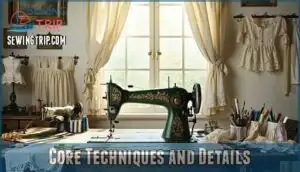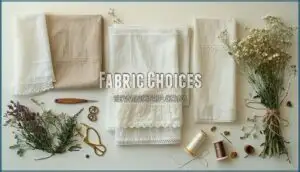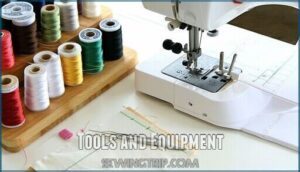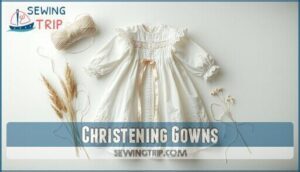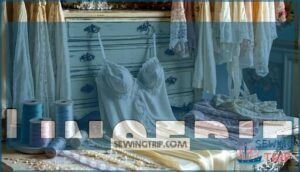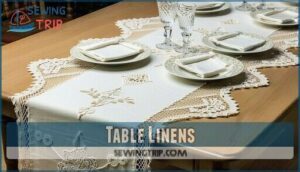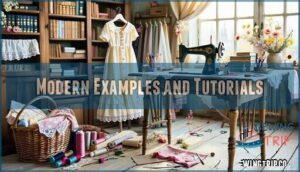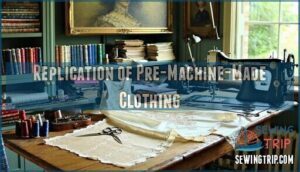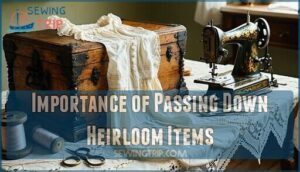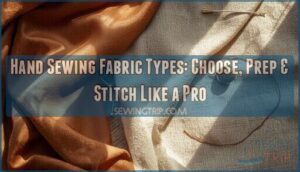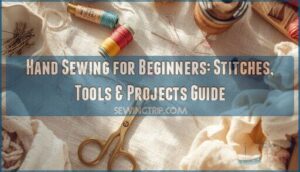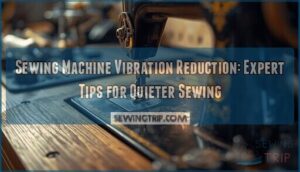This site is supported by our readers. We may earn a commission, at no cost to you, if you purchase through links.
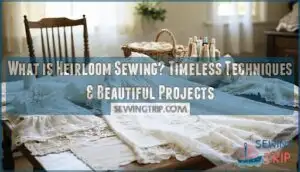 Heirloom sewing is the art of creating timeless garments using traditional hand-sewing techniques that mirror pre-industrial craftsmanship.
Heirloom sewing is the art of creating timeless garments using traditional hand-sewing techniques that mirror pre-industrial craftsmanship.
You’ll work with delicate fabrics like Swiss batiste and silk organza, incorporating French seams, lace insertion, intricate tucks, and fine embroidery.
This fastidious craft transforms simple materials into family treasures—christening gowns, wedding dresses, and table linens that withstand generations.
Unlike fast fashion, heirloom sewing demands patience and precision, but rewards you with pieces that tell stories through every carefully placed stitch.
It’s not just about creating beautiful items; it’s about mastering techniques that connect you to centuries of skilled artisans who understood that true quality transcends time.
Table Of Contents
Key Takeaways
- You’ll master traditional French hand-sewing techniques like lace insertion, pintucks, smocking, and hemstitching to create garments that’ll last generations, using delicate fabrics like Swiss batiste and fine cotton.
- You’re not just sewing clothes—you’re creating family treasures meant to be passed down through generations, with each piece carrying stories and connecting past, present, and future family members.
- You’ll need specialized tools including fine 50-60 weight threads, twin and wing needles, stabilizers, and pleating equipment, plus you’ll invest significantly more in premium materials compared to regular sewing projects.
- You can expect to spend 6-12 months learning basic techniques and 2-3 years mastering advanced skills, but you’ll create timeless pieces like christening gowns, wedding dresses, and table linens that withstand decades of use.
Origins and Influences
Picture a monastery in late 19th-century France, where French Nuns bent over delicate fabrics, creating exquisite garments for European royalty.
heirloom-sewing-blockquote
text/markdown
Heirloom Sewing Blockquote
Every stitch whispers history, transforming humble fabric into treasured heirlooms through devoted hands.
This Royal Influence sparked what we now call heirloom sewing—a fastidious craft rooted in French hand sewing techniques that would define generations of needlework.
You’ll find these Historical Roots deeply embedded in the Victorian Era and Edwardian Style periods, when intricate undergarments and children’s clothing showcased breathtaking detail.
Think of it as the original slow fashion movement—every stitch deliberate, every seam precious.
While machine manufacturing nearly buried this traditional sewing art, the 1970s brought unexpected revival.
Modern sewists rediscovered vintage sewing methods, breathing new life into antique sewing practices.
Today’s heirloom sewing marries historical authenticity with contemporary creativity, proving that some traditions refuse to fade into history’s fabric.
Core Techniques and Details
You’ll master five essential techniques that define heirloom sewing: lace insertion, tucks, smocking, embroidery, and hemstitching.
These methods, refined through centuries of craftsmanship, transform simple fabrics into intricate masterpieces through precise stitching and careful attention to detail.
Lace Insertion
Lace insertion transforms ordinary fabric into extraordinary heirloom pieces through precise placement of delicate laces between fabric sections.
This cornerstone technique of French lace artistry requires painstaking attention to fabric selection and edge finishing methods.
Master these essential lace techniques:
- Precise cutting – Create clean openings using sharp scissors for seamless lace accents
- Stabilized fabric – Prevent fraying during insertion with proper preparation methods
- Even tension – Maintain consistent stitching for professional decorative stitches
- Quality materials – Choose compatible fabrics and insertion methods for lasting results
To achieve professional-looking lace insertion, understanding lace insertion techniques is vital for successful heirloom sewing projects.
Tucks
How do tucks transform ordinary fabric into extraordinary heirloom pieces? These precise folds create stunning texture and visual interest through various tuck techniques.
You’ll master pintuck methods using specialized feet, while corded tucks add dimensional elegance. Single tucks offer subtle sophistication perfect for bodices and sleeves.
Mastering tuck sewing tools is essential for achieving professional results with sewing tuck tools.
| Tuck Type | Best Use | Tools Needed |
|---|---|---|
| Pintucks | Bodices, sleeves | Twin needle, pintuck foot |
| Corded Tucks | Formal wear, details | Cording foot, fine cord |
| Single Tucks | Hems, borders | Standard presser foot |
| Clustered Tucks | Decorative panels | Quilting guide, marking tools |
Your texture creation skills will flourish as you combine these sewing techniques with lace insertion for breathtaking results, creating extraordinary heirloom pieces.
Smocking
Through centuries of textile artistry, smocking transforms ordinary fabric into extraordinary masterpieces using specialized gathering stitches and pleating methods.
This intricate fabric manipulation technique creates controlled texture while maintaining elasticity, making it perfect for fitted garments.
Master these essential smocking techniques:
- Precise gathering stitches that create uniform pleats
- Traditional pleating patterns passed down through generations
- Controlled fabric manipulation for structured flexibility
- Decorative smocking variations adding visual interest
- Heritage gathering techniques preserving timeless craftsmanship
To achieve professional results, understanding smocking techniques is essential for any serious sewing enthusiast.
Embroidery
Embroidery transforms ordinary fabric into treasured keepsakes through carefully planned stitch variations and precise needle control.
Your thread choices determine the final character—silk creates lustrous highlights while cotton offers subtle texture.
Master embellishment techniques by starting with simple running stitches before advancing to French knots and satin work.
| Technique | Best Application |
|---|---|
| Satin Stitch | Filling small shapes |
| French Knots | Adding texture dots |
| Running Stitch | Outlining designs |
| Chain Stitch | Creating flowing lines |
Focus on fabric selection that supports your embroidery sewing goals.
Lightweight batiste holds delicate heirloom embroidery designs beautifully, while firmer weaves support dense stitching without puckering, allowing for precise needle control and creating a beautiful final character.
Hemstitching
Mastering hemstitching transforms ordinary fabric edges into works of art through precise decorative stitches and fastidious fabric preparation.
This essential heirloom sewing technique creates elegant openwork patterns by drawing threads and securing them with specialized stitch variations.
Whether you’re perfecting edge finishing on christening gowns or adding sophisticated embroidery sewing details, hemstitch basics elevate your heirloom embroidery designs with timeless sophistication.
Fabric and Trim Choices
You’ll achieve authentic heirloom results by selecting traditional fabrics like Swiss batiste, Japanese lawn, and Irish linen, which provide the lightweight, fine-woven foundation essential for delicate techniques.
Your trim selections should include French and English cotton laces, Swiss embroidered details, and silk ribbons in soft, muted tones that complement the vintage aesthetic and guarantee long-lasting beauty, with delicate techniques.
Fabric Choices
Your fabric selection forms the foundation of every stunning heirloom piece.
Swiss batiste remains the gold standard—its fine weave creates the perfect canvas for intricate techniques.
Cotton fabrics like lightweight voile and premium lawn offer excellent alternatives, while delicate fabrics such as Irish linen provide unique texture.
Consider fabric weights carefully; mid-weight materials support complex embellishments without overwhelming delicate details.
High-quality fabrics make your textile selection withstand generations, making thoughtful fabric choice absolutely essential for lasting heirloom treasures.
Understanding Swiss fabric types is pivotal for selecting the perfect material for your project, and choosing the right fabric is crucial for creating a lasting and beautiful piece that will be treasured for generations.
Preferred Trims
Selecting the perfect trims transforms ordinary fabric into heirloom treasures.
Cotton lace options range from delicate French varieties to intricate Swiss designs, while ribbon choices include lustrous silk and vintage-inspired cotton.
Your trim selection should complement your fabric’s weight and texture.
Master edge finishes by pairing lace trims with silk ribbon embroidery for stunning results.
These embellishments, combined with decorative stitching and refined embroidery techniques, create the timeless elegance that defines authentic heirloom sewing projects.
Tools and Equipment
You’ll need specialized tools and equipment to achieve the precise, delicate results that define heirloom sewing.
Essential items include fine threads ranging from 50 to 60 weight, specialized needles like twin and wing varieties.
Tear-away stabilizers for fabric support, and specific machine feet such as edgestitch and buttonhole attachments are also necessary.
Fine Threads and Needles
Thread selection forms the foundation of exceptional heirloom work. You’ll need 50-weight or 60-weight polyester, silk, or mercerized cotton for delicate fabrics.
Needle varieties include twin, triple, wing, and double wing needles, each serving specific techniques. Fine threads require precise stitch tension adjustments to prevent puckering.
Test fabric compatibility before starting your project. Proper needle types guarantee sewing precision while protecting delicate materials.
Quality sewing threads elevate your finished pieces substantially. The choice of thread is vital, considering heirloom threads for the best results.
Stabilizers
Something magical happens when delicate fabrics meet the right stabilizer—your heirloom projects transform from frustrating struggles into smooth victories.
These fabric support heroes prevent puckering, distortion, and those dreaded "oops" moments during intricate stitching.
Choose your stabilizer weapon wisely:
- Tear Away stabilizers for permanent support during heavy embroidery
- Water Soluble options that disappear completely after washing
- Cut-away types for stretchy or delicate fabrics requiring lasting edge control
- Spray starch as a temporary, budget-friendly alternative
- Fusible stabilizers for quick, heat-activated application
Different stabilizer types serve specific purposes in your heirloom arsenal.
Pleaters
The magic of pleaters transforms ordinary fabric into extraordinary textured masterpieces that’ll make your grandmother’s sewing circle green with envy.
These specialized pleater tools create precise, uniform pleats essential for authentic smocking techniques and intricate fabric folding patterns.
Professional pleaters range from simple handcranked pleaters perfect for small projects to sophisticated machine pleaters that handle larger garments with ease.
The Amanda Jane Smocking Pleater, holding 24 needles, represents the gold standard for creating consistent pleat patterns and gathering methods.
Remember the cardinal rule: "long is wrong" when positioning fabric. Always place fabric wrong-side up in Read pleaters for ideal results.
Essential considerations for successful pleating include:
- Needle Configuration: Choose between 8 to 24 needle setups based on your project’s complexity and desired pleat density
- Fabric Compatibility: Lightweight cottons and batiste work best, while heavier fabrics challenge standard pleating mechanisms
- Complementary Tools: Pair pleaters with pintuck foot and cording foot attachments for seamlessly integrated heirloom details
To achieve professional results, understanding pattern drafting tools is vital for creating intricate designs and precise fittings.
Projects and Styles
You’ll find heirloom sewing techniques applied across four primary categories: wedding dresses, christening gowns, lingerie, and table linens, each requiring specific fabric selections and construction methods.
These projects showcase the craft’s versatility, from intricate lace insertion on bridal wear to delicate pintucks on baptismal garments, demonstrating how traditional French hand sewing adapts to formal occasions and everyday elegance, with a focus on heirloom sewing.
Wedding Dresses
Wedding dresses represent the pinnacle of heirloom sewing artistry, where generations of brides find their perfect match.
You’ll discover how bridal lace techniques transform silk fabrics into stunning heirloom gowns that capture your unique story.
Vintage brides often choose these timeless methods to create wedding veils and bridal gowns with intricate embroidery details.
| Style Feature | Technique Used |
|---|---|
| Victorian Sleeves | Gathered lace insertion with pintucks |
| Bohemian Bodice | Hand-sewn embroidery on silk batiste |
| Classic Train | French seams with hemstitched edges |
| Vintage Neckline | Fagoting joins delicate lace panels |
Christening Gowns
Beyond the grandeur of bridal couture lies another domain where heirloom sewing truly shines.
Christening gowns represent the pinnacle of sacred garment creation, where every stitch carries profound meaning.
These baptismal robes aren’t just infant attire—they’re tangible prayers wrapped in fabric.
When you craft christening dresses using French hand sewing techniques, you’re creating something that’ll witness baby blessings across generations.
The delicate lace insertion work transforms simple fabric into sacred garments worthy of life’s most precious moments.
Your needle becomes an instrument of devotion, weaving together cotton batiste with imported laces to create heirloom pieces that’ll outlast trends.
Traditional christening gowns feature intricate pintucks, delicate embroidery, and heirloom sewing techniques passed down through centuries.
The handmade quality speaks to the heart—each gathering stitch, each carefully placed ribbon tells a story.
You’re not just sewing; you’re creating a keepsake that’ll carry forward family traditions, one careful stitch at a time.
Lingerie
Through heirloom sewing techniques, you’ll transform intimate apparel into treasured pieces that celebrate feminine craftsmanship.
French hand sewing elevates simple undergarments into works of art, where delicate elegance meets personal expression. Your handmade elegance shines through carefully placed lace insertions and silk ribbon details that create lingerie worthy of passing down through generations.
- Silk Camisoles – Perfect canvas for practicing pintucks and delicate embroidery stitches
- Lace Slips – Showcase your lace insertion skills with vintage-inspired trim combinations
- French Corsets – Master complex construction techniques while creating structured, beautiful foundations
- Satin Gowns – Ideal for advanced hemstitching and French seam finishing methods
- Boudoir Wear – Express creativity through smocking, fagoting, and personalized embellishments
Table Linens
Creating stunning table settings becomes effortless when you master heirloom sewing techniques for elegant table linens.
Fine fabrics like linen and batiste showcase intricate lace insertion along table runners, while delicate embroidery transforms ordinary placemats into treasured pieces.
Linen embellishments add sophistication to napkin rings, and placemat designs featuring hemstitched edges create restaurant-quality dining experiences.
Your guests will marvel at these handcrafted masterpieces that elevate every meal into something special, with elegant table linens that showcase your attention to detail.
Modern Examples and Tutorials
You’ll find contemporary heirloom sewing through structured baby gown sew-alongs, thorough French hand sewing technique guides, and tutorials showcasing innovative machine applications.
These resources demonstrate how traditional methods adapt to modern tools, providing step-by-step instruction for mastering pintucks, lace insertion, and hemstitching techniques using today’s specialized sewing equipment.
Heirloom Baby Gown Sew-Along
Brother’s Expert Sewing Consultant Janice Ferguson leads an inspiring Baby Gown Patterns workshop that transforms traditional heirloom sewing into accessible artistry.
Her collaboration with Brother International and Classic Sewing Magazine demonstrates how modern Sewing Tips enhance classic techniques using premium Heirloom Fabrics.
Ferguson’s Baby Sewing approach to Gown Construction includes these heartwarming elements:
- Delicate lace insertion techniques creating timeless beauty
- Precision pintucks adding elegant texture
- French seam finishes ensuring lasting durability
- Ribbon threading methods for personal touches
- Hand-embroidered details expressing pure love
Her handmade sewing expertise makes complex sewing techniques achievable for dedicated crafters seeking to create treasured heirloom garments.
French Hand Sewing Techniques
French Hand Sewing transforms ordinary fabric into extraordinary heirloom pieces through precise Hand Stitching techniques.
You’ll master lace insertion by controlling thread tension and Needle Control while selecting appropriate Thread Choices for delicate work.
Fabric Preparation involves starching lightweight materials before stitching.
These hand sewing methods require quality Sewing Notions and patience, and techniques like Smocking add textural dimension through carefully gathered pleats, creating timeless garments that showcase traditional craftsmanship.
Innovative Sewing Machines
Modern sewing machines have revolutionized the way you’ll approach traditional needlework, bringing cutting-edge technology to timeless craftsmanship.
These innovative techniques merge machine sewing precision with embroidery machine capabilities, transforming your creative process through advanced sewing equipment.
Today’s sewing automation features enhance your heirloom projects with:
- Machine Embroidery systems that digitize intricate vintage patterns with flawless reproduction
- Needle Technology offering specialized wing and hemstitch needles for authentic vintage effects
- Thread Innovations providing consistent tension control across delicate fabrics like batiste
- Stitch Precision enabling perfect pintucks and fagoting through computerized stitch regulation
- Digital Pattern Libraries storing hundreds of traditional motifs for instant access
Replication of Pre-Machine-Made Clothing
Authenticity drives heirloom sewing’s mission to recreate historic garments from the Victorian era and Edwardian fashion periods. You’ll discover that vintage patterns serve as your roadmap, guiding each delicate stitch placement just as seamstresses did centuries ago.
Hand sewing becomes your primary tool, mimicking the careful construction methods used before machines dominated textile production. When working with antique fabrics or period-appropriate materials, you’re basically becoming a textile detective.
French hand sewing techniques like fagoting and pintucks weren’t just decorative—they were structural necessities. These heritage crafts required seamstresses to spend weeks on a single garment, creating the intricate details we admire today.
Historical sewing techniques demand patience and precision. You’ll find yourself studying museum pieces, analyzing seam construction, and reverse-engineering buttonhole placements. This isn’t just sewing; it’s archaeological recreation through fabric and thread.
Understanding denim embroidery techniques can also inform your approach to working with other sturdy fabrics in heirloom sewing projects.
Importance of Passing Down Heirloom Items
Creating these masterful garments becomes profoundly meaningful when you understand their role as generational treasures.
Your heirloom sewing projects aren’t just beautiful clothing—they’re tangible links connecting past, present, and future family members.
When you pass down handcrafted christening gowns or wedding dresses, you’re sharing more than fabric and thread.
These pieces carry sentimental value that transforms simple garments into powerful symbols of family legacy.
Each delicate stitch tells a story, preserving cultural heritage through traditional crafts that might otherwise disappear.
Heirloom preservation strengthens intergenerational bonding in ways digital photos can’t match.
Your granddaughter will feel the weight of history when she wears your hand-sewn baptism gown.
She’ll understand her place in family traditions through these physical connections to ancestors she’s never met.
Legacy sharing through heirloom sewing creates lasting memories while teaching younger generations to value craftsmanship.
You’re not just creating clothing—you’re weaving family history into every seam, ensuring your creative legacy endures for decades.
By embracing sewing lessons, you can refine your skills and create truly timeless pieces.
Frequently Asked Questions (FAQs)
What are heirloom fabrics?
Heirloom fabrics include fine cotton batiste, Swiss broadcloth, Japanese lawn, and Irish linen.
You’ll find them in white, ecru, and soft pastels, providing the delicate foundation needed for intricate lace insertion and embroidery work.
What is the meaning of heirloom clothes?
Like treasured family recipes passed through generations, heirloom clothes represent garments crafted with precise French hand-sewing techniques, designed to last decades.
You’re creating wearable art meant to survive countless washings and become cherished family keepsakes.
What is heirloom quality clothing?
Quality clothing you’ll treasure involves fine fabrics, exquisite construction techniques, and fastidious finishing details.
You’re investing in garments crafted with French seams, delicate hand-stitching, and premium materials that’ll last generations with proper care.
What is the hardest sewing technique?
Like Sisyphus eternally pushing his boulder, you’ll find hand-sewn French seams the most challenging technique.
They demand perfect tension control, microscopic stitches, and endless patience—but they’ll reward you with garments that truly last generations.
How long does heirloom sewing take to learn?
You’ll need 6-12 months to master basic techniques like pintucks and lace insertion.
Advanced skills including smocking and intricate embroidery require 2-3 years of consistent practice to achieve the precision this delicate craft demands.
What are common beginner mistakes in heirloom sewing?
Beginners often rush delicate techniques, skip stabilizers, use wrong needle types, and choose heavy fabrics. You’ll also struggle with tension settings, forget pre-testing stitches, and attempt complex projects too early.
How do you care for heirloom sewn garments?
Ninety percent of heirloom garments last decades with proper care.
Hand-wash your delicate pieces in cool water using gentle detergent, then air-dry flat.
Store them folded in acid-free tissue paper to preserve their intricate details.
Can heirloom techniques work on modern fabrics?
You can adapt heirloom techniques to modern fabrics like lightweight cotton blends or even synthetics.
Just make certain proper stabilizers, fine needles, and threads for precision.
Experimenting with bold colors adds a contemporary twist too!
Whats the cost difference versus regular sewing?
Your wallet will feel the difference.
Heirloom sewing costs substantially more than regular projects—specialty fabrics, fine threads, and delicate trims can triple your material expenses.
But you’re investing in timeless pieces worth passing down.
Conclusion
Like the patient hands of Victorian seamstresses who created garments destined for generations, you now understand what heirloom sewing represents—a bridge between past and future craftsmanship.
You’ve discovered techniques that transform simple fabrics into treasured keepsakes through painstaking attention to detail.
Whether you’re creating christening gowns or wedding dresses, these traditional methods guarantee your work will endure.
Remember, heirloom sewing isn’t just about technique; it’s about preserving stories through every carefully placed stitch, making each piece a lasting testament to the craftsmanship and love that went into its creation, ultimately becoming a treasured keepsake.
- https://www.nber.org/papers/w26408
- https://www.loc.gov/classroom-materials/united-states-history-primary-source-timeline/rise-of-industrial-america-1876-1900/immigration-to-united-states-1851-1900/
- http://www.marthapullen.com/
- https://janome.com/en/accessories/sewing-machine-feet/3-way-cording-foot/
- http://content.janome.com/en/accessories/sewing-machine-feet/pintucking-foot/

